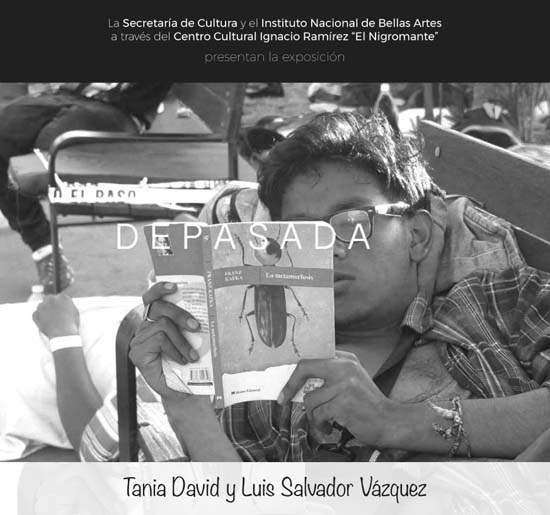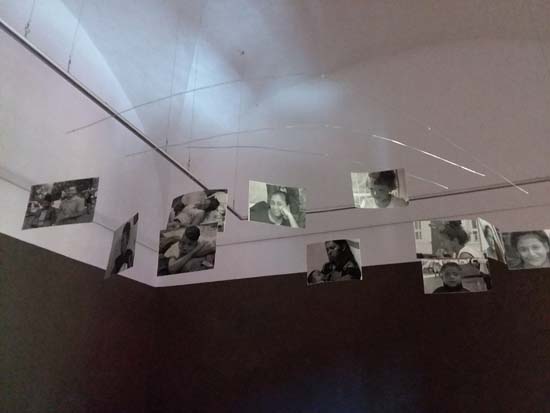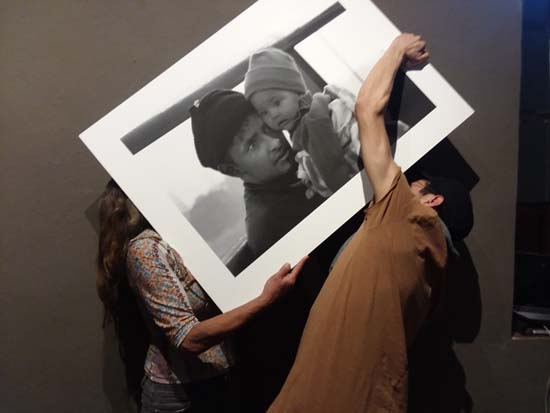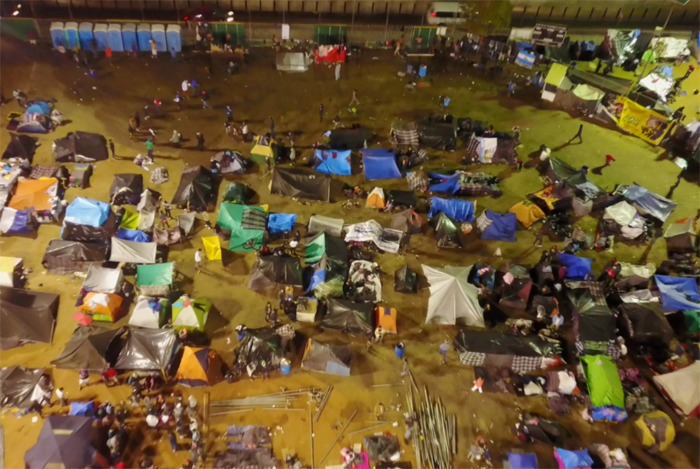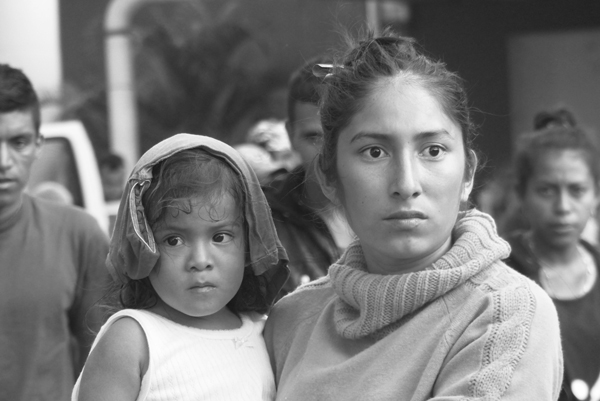Depasada (Passing By)
Nancy McGalliard
March 2019
The art installation, Depasada (Passing By), at the Bellas Artes in San Miguel de Allende, Mexico by Tania David & Luis Salvador Vázquez consists of a black room with two video projections on the wall, a gently turning mobile of black & white portrait images hanging from the center of the room, 3 large black & white portrait photographs of people who were in the migration, a pile of black shoes spilling out from the corner of the room and a notebook of relevant articles available to read. The artists’ statement is hand-written in English and Spanish on two walls.
One video projection shows people talking about why they are fleeing and what they hope will happen when they get to the USA border. They are candid and often emotional. A second video is of birds migrating, a train passing known as “The Beast,” and people walking, constantly in motion, a flowing river of humanity. The two projections dominate the room with sound and practically life-sized images of refugees sharing their fears and hopes as they rest for a minute to be interviewed. It is impossible to turn away from these stories and faces. They are full of individuality, hopes, and dreams and are not just news story victims.
The mobile of portrait photographs slowly rotates with images of refugee travelers. The faces are always in motion reflecting unsettled, uprooted lives in flux. Motion is of course the dominant theme.
The pile of black shoes was collected at the safe houses. They appear to tumble from the corner wall as though overflowing out of the roads they traveled, footsore and despairing.
There are three large photographs. In one a woman with a young child looks directly at you. The Mother’s expression seems to be stricken or in shock. She stares directly into the camera while the child’s eyes seem to be looking all around her. Life is no longer happening in the rhythm and pattern the little one is used to. Everything is new, different. Nothing stays put.
In a second photograph a young man holds his little baby against his cheek and up to the camera with great tenderness. The vigor and hope in a young man’s life is now an uneasy stare towards an uncertain future. The baby starts his journey in life on the road fleeing violence.
One of the most mesmerizing images on the wall is a black and white photograph of a young bespectacled man reading Kafka’s “Metamorphosis”, a surreal story about a man turning into an insect, a story of extreme change and transformation. It seems to parallel the experience of the refugees, a heightened surreal migration where nothing is rooted in time, the perpetual tributary of people snaking north towards freedom.
Depasada is successful in its strong focus on the refugees both intimate and global. Visually this installation evokes understanding of the plight of the individual as well as a larger population experiencing upheaval. And this is only one migration. They are happening all over the world due to climate change, war, violence, and poverty.
The people talking in the video are real and vulnerable. One feels in touch with them, conversationally engaged. They have been pushed to the point of running away from their homes and families by real violence and poverty. Their fear is palpable and their desperation is intense. The exhibition begs the question “what would make you leave home and family and undertake a dangerous trip on foot with children or on your own?” And if you can imagine this you may gain compassion, and in the best case scenario you engage in activism and become a participant of change.
A RIVER THAT NEVER ENDS
Every day, men, women and children from Central America, mainly from Honduras, pass through Celaya, San Miguel de Allende, Queretaro and surrounding communities. There’s been an unending flow of people fleeing violence and poverty in search of a safe place to live.
We interviewed many of these people and want to give voice to each of them speaking of why they’ve left, the conditions in their country, their journey and their dreams. As were visited safe houses and interviewed those in the caravan, we began to understand their desperation. Some are fleeing from death threats to themselves or their families, from extortion or gang violence. We heard stories of families losing their homes and watching their relatives murdered. Some are victims of climate change, farmers unable to make a living because of drought. Some are fleeing years and years of unemployment and corruption. Many are unable to feed their families or send their children to school. With the caravan passing through our towns, we joined and followed with our cameras to the border.
This search for asylum is and continues to be complex. Some have decided to apply for asylum in Mexico and others have chosen to face the risks of going to the US. Some have simply made the decision to turn back due to fear or illness. We heard stories of exploitation and extortion by gangs, in Mexico and at the border, stories of deaths and injury on ‘the beast,’ the train carrying these refugees through our towns.
Forced migration is a worldwide crisis that needs our response.
– Tania David & Luis Salvador Vázquez
Instituto Nacional de Bellas Artes
San Miguel de Allende, Mexico
February 1 – April 14
◊
Nancy McGalliard has been an artist most of her life. She has a Masters of Fine Arts degree from University of Guanajuato through San Miguel de Allende Instituto Annex. She’s currently living in Huntsville Texas.
You can see photographs of the caravan by Tania David on Arteidolia
Caravan in Irapuato/Guanajuato

